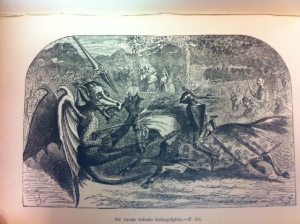Among the strange creatures that feature in the Pollard collection is the Dragon. This legendary animal is found in both European and Asian myths. The Asian dragon traditionally resembles a large snake, while the European one is more lizard-like, with two or more legs. The word dragon comes from the greek word for a water snake. A dragon-like creature, Humbaba, appears in one of the oldest stories in the world, the Epic of Gilgamesh. This was written down in Mesopotamia in the 18th century BC. In the story, King Gilgamesh and his friend the wild man Enkidu fight the fire-breathing Humbaba. Here is one description of the creature, from a translation by Georg Burckhardt: ‘He had the paws of a lion and a body covered in horny scales; his feet had the claws of a vulture, and on his head were the horns of a wild bull; his tail…ended in a snake’s head.’ I think that qualifies as the first description of a dragon. Let me know if you agree.
One of the dragon books in Pollard is called Tuflongbo and Little Content – Their Wonderful Adventures in the Enchanted Forest, written by Holme Lee (real name Harriet Parr) in 1861. The edition in Pollard is from around 1889, and the illustrations above and below are found in its pages. You can read the first edition of the book, digitised by Google from the Bodleian library, by clicking here.



3 thoughts on “Here Be Dragons”